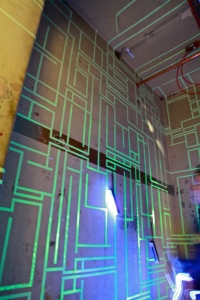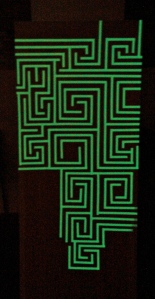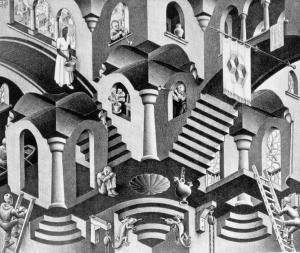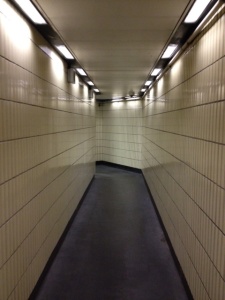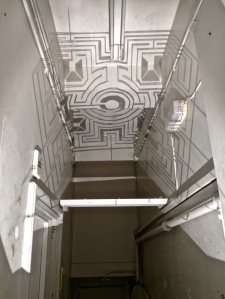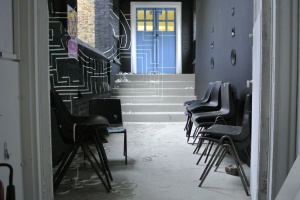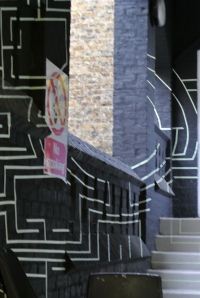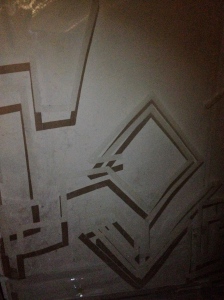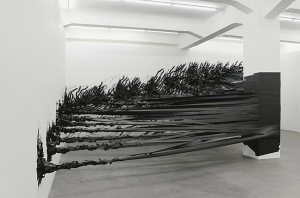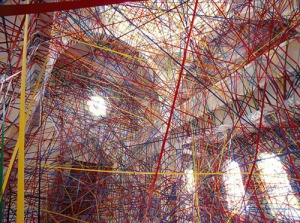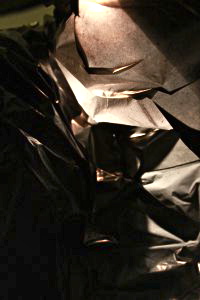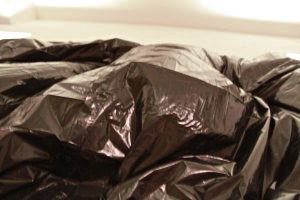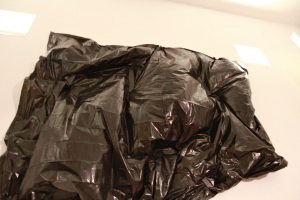Exhibition Notes
The outcome has been that I do not have a plug socket therefore the torches will be my light source for the piece. I have also had to contemplate what to do about external lighting from other rooms. When we first visited Shoreditch Town Hall the overhead fluorescent lights were not on giving the space far more mystery and darkness however with them on it is far brighter overall and also very bright in my space in which I am to create my installation.
I have been given a very interesting space to work in, it is a sort of corridor but by no means frequently used which is ideal. The dimensions are 4ft x 4ft x 10ft, and considering the price of photo-luminescent tape this has actually proved to be far more reasonable compared to the grand schemes I presented in the proposal. The corridor is somewhat of a void space, it holds no real purpose except from using it as a short-cut to get to the adjacent main room. The walls of the area work very well with tape even when it isn’t glowing. As the walls are mottled with peeling layers of paint, the tape gives the illusion that it is almost a support mechanism for the old building. The contrast is very effective.
I have decided to hang 6 torches at different heights around the room. Through this I hope to open the invitation to the viewer that they can pick up the torches and use them to illuminate the tape themselves. Due to the strength of the lights patterns are able to be made directly onto the tape almost instantaneously. The work has become interactive on many levels and relies on audience participation to expand the glow of the pattern.
Many people have remarked that the piece is very similar to circuit boards and other technological references. I am very willig to welcome this perception, especially in relation to the title of the piece. Inspired by a text that we read in Unit 5 about the ‘otaku’ of Japan and their obsessions with online role playing games, I feel that the piece can offer the same social anxiety due to the tensions between the real and the virtual space.
A Circuit Board
To get the optimal darkness I chose to add a curtain to one of the two doorways into the room. This decision was very last minute but I felt the idea of encaging the viewer would be far more noticeable with this addition. I didn’t curtain both entrances as I wanted to lure the viewer easily in on one side of the room and keep them there with the aid of the curtain.
I wasn’t able to cover the floor of the room in tape as it was far too dusty and inhibited the tape from sticking. I did attempt to incorporate the ceiling however this was a very difficult task due to the height of the walls and the shortness of the ladder. My design was also only designed on a 2-D plane and therefore transferring it onto the room caused a few difficulties, but like most of the wall pattern I decided to improvise the design.
‘Incubate’
Above are images of a practice piece I did in the lead up to the exhibition. Above I have used a large board and attempted at an autonomous maze pattern, similar to the one I want to execute in Shoreditch Town Hall. Here I have effectively used my new knowledge of lighting in order to receive the optimum amount of glow out of the tape. The piece is exceptionally hard to photograph due to the low light conditions that the tape requires in which to glow fully, hence the blur of the photographs (I did not have a tripod).
I have recently learnt that I may not have access to a plug socket in the exhibition space. This news has made me completely rethink the viability of this piece. However I have looked into UV torches that are used in shops to detect fraudulent bank notes. Depending on the outcome of this news, I may have to realistically think about using the torches as my primary light source. The torches do not give off that much light and therefore will need multiple ones that can afford to be on constantly as I have already tested them and they still make the tape glow without interrupting the dark environment massively.
I have also been considering the name of the piece. When really sitting down and contemplating the ideal purpose of the piece I came across the word ‘INCUBATE’. My aim is to achieve an environment that involves everybody who walks into it and affects them in different ways. The environment is much like a climate, a climate of anxiety, wonder and guidance. I feel as the creator of this piece I am trapping the audience and putting them in an environment that I want them to respond to and keep them there for as long as possible. It is a room that I want to be an enclosed catalyst for claustrophobia and other visual distortions and disorientation. The definition of ‘incubate’ is primarily medical and to do with hatching or embryonic development, I caught onto the principle that it is the maintenance of specific conditions in order to promote a particular reaction. However my piece is contradictory to the definition as my work does not promote growth or development but instead encages them, stunting a healthy growth. Another aspect of my work that led me to the word ‘Incubate’ was the pulsating nature of the tape’s glow. Despite being charged it will fade, but with the UV light the glow and life of it is easily restored. Something that I hadn’t originally thought of is that maybe it is not the audience that I am incubating but in actual fact it is the tape. The depends on a light source in order to glow, and only through myself can the tape access this light in the dark labyrinth of Shoreditch Town Hall.
Exhibition Preparation
‘Wireframe’ (2010)
In preparation for the exhibition I needed to gain as much knowledge about photo-luminescent tape in order not to fully utilise it as my medium. Above are images of the artist Scott Rogers’ work which also includes photo-luminescent tape and after reading interviews with him I felt I had widened my knowledge of the requirements needed to get the best glow from the tape. Ultra-violet (black-light) lighting offers the optimum amount of glow for the tape, as fluorescents contain different colours of the spectrum which reduce the efficiency of the tapes light absorption.
As light is essential for the flow of the tape, I require somewhere with a plug socket. I have brought a UV lightbulb and an inspection lamp to add to the cagey environment I am aiming to create. Through reading more about photo-luminescent tape I am very aware that this is an exceedingly hard medium to work with. The light I want to use will have to be plugged into a light module that is set with a timer. This will ensure that the light is on for a period to charge the tapes glow and then turns off shortly afterwards in order for the UV lightbulb to not overheat (as they are notorious for doing so). This cycle needs to be repeated as often as possible so the tape’s glow doesn’t fade and so does not leave my piece in complete darkness and therefore inevitably get ignored.
The pattern which I will use is still undecided. Due to have only viewing the exhibition space once it is impossible to create an exact version of the labyrinthine image I want to tape onto the walls. I will carry on testing possibilities, however when the piece is being installed it is very much going to be an improvised, autonomous version of anything I design.
The installation will be site-specific ideally, the only thing that will prevent this from happening is the possibility that the paint work on the walls of the Grade II listed building will not tolerate being taped over. This is a possibility I have greatly thought over, if this was to be the case I have thought of create a web of photo-luminescent tape stuck back-to-back and suspended around the perimeter of the room. This will hopefully given a similar effect but definitely is not an ideal option.
Exhibition Proposal
After looking round the Shoreditch Town Hall space I was very excited about writing my proposal. The space is a labyrinth in itself, with many darkened pockets that appear claustrophobic and restricted. I was still unsure whether the medium of photo-luminescent tape was something I wanted to continue with further, however I was very aware that I hadn’t reached the full potential of the medium and therefore felt it necessary to give it one final opportunity.
The locations that appealed to me most were long narrow rooms, I wanted to avoid corridors so I could truly trap the audience in y enclosure. Ideally, the floors and the walls and the ceilings will be densely covered in a very complicated and nonsensical pattern. When discussing the proposal with others many felt the medium was a gimmick and too reminiscent of the film ‘Tron Legacy’ to be taken seriously as an art form. However I knew I want to carry on with the photo-luminescent tape and believe I can banish the gimmickry of the tape. I looked at the tape in a similar way to that of neon lighting and the connotation surrounding that which I wrote about for my Unit 5 assessment.
Above are images from Google SketchUp which I used to create a rough template of my idea. I found the program very useful and effective at creating a mock version to elaborate from in the final piece.
Op Art
Through abolishing gradients in the piece outside with photo-luminescent tape many people drew comparisons to Op Art. In particular the art of Bridget Riley (see below).
Another artist that I was told to explore further was Escher.
‘Convex and Concave’ (1955)
The true effectiveness of both the artists are their manipulation of the pictorial plane. These manipulations are therefore put onto the viewer through the tricks of the eye. Whilst Escher’s work is far more linked to the idea of a puzzle, through the use of tessellation, whereas Riley bombards the viewer with high contrast and hallucinogenic comparisons. The viewer becomes enraptured due to the sense of deception that they are feeling against their own visual prowess.
Gregor Schneider also uses repetition to unhinge his viewers stability. Although his work does not consist of geometric lines and a lengthily thought out composition, the uneasiness derives fromt the repetition of the banal. His use of similar colours and materials in a very ordinary enclosure, yet create clinical and preconceived environments in a labyrinthine accumulation.
The work of Gregor Schneider is reminiscent of Mike Nelson’s work that appeared in the Tate a couple of years ago. His labyrinth entitled ‘The Coral Reef’ inflicted disorientation on the viewer, like the similarity of lines in Op Art, the room had little variation causing the viewer to second guess their innate navigational skills an short-term memory. It was an experience very similar to my visit to Alcatraz:
This cave like environment is something I would definitely like to take further. It has also led me to think of the everyday labyrinths which we are unaware of. The most obvious of course is the London Underground. The vast expanse of tunnels, stairs and escalators all combine to be the most elaborate labyrinth of all yet the aid of signage seems to provide sufficient guidance, the authority of the signs (and who they are provided by) seems to give the public confidence, those signs will always be followed and trusted.
Berlin U-Bahn
Elephant & Castle Underground
Photo-Luminescent Tape
When returning back to the photo-luminescent tape I used previously as a guidance in the bin liner jungle I felt this was the medium I wanted to explore further due to its vast potential. One aspect of the tape that I was particularly interested in was the tape’s dependence on myself or the viewer to allow it a light source to which it can absorb and therefore glow. Despite photo-luminescent tape used primarily as a guidance line (for example in the college photographic dark room where it enables people to navigate around the room without any form of lighting) I feel that it can also be manipulated like any other density of linear patterns to almost create a cage environment.
For my first experiment with the tape I wanted to incorporate the idea of viewer participation by projecting onto a corridor a maze-like pattern and then draw over the lines with the tape. Through this a bizarre and very confusing pattern will be created, almost completely abstract unless it is viewer from the point of the projector and then all the lines will fall into play and reveal the overall image, rather than snippets which is all you will be able to see from any other angle.
Looking for possible locations to put the tape onto. The corridor above is never seen from the angle in which the pattern will look complete and therefore I feel the piece will get easily overlooked and never able to be seen in the desired way. The lighting is also constantly on and turning it off would be disruptive. My next idea is to put in outdoors and on the bridge between the two buildings at Camberwell.
Outdoors I am able to make the piece have an element of excitement, it allows the viewer to stumble upon it without knowledge. When walking across the bridge from one direction the piece will virtually not be able to be seen, however from the other direction the piece unfolds in its entirety. The black walls also work very well for the piece, as even when the tape is not glowing it can still present the desired aesthetic value I wanted to portray. The steps are reminiscent of the piece in the faith room and this incorporation of multi levels are interesting as hopefully when the piece is looked at from the optimal viewpoint the steps will merge into the one image and therefore eliminate gradients and contours of the area.
Above are images of the final piece using photo-luminescent tape.
Overall the piece did fulfil most things I set out to accomplish however there are some main drawbacks. As the piece was outside the glow of the tape was only viewable when it was dark outside which had limitations on how many people would see it when it glowed. The glow of the tape does not last long enough and I hadn’t done thorough research into finding out what lighting works most effectively with the tape and therefore was not using the medium to its full potential. As the piece was outside it did not encompass the sense of an enclosure that I really wanted to put across, no claustrophobia or agoraphobia could be sensed and there were many distractions fromt the outside scenery which did not lend itself to the piece, especially when it wasn’t glowing. Positives of the piece were: the elimination of contours and the effectiveness of having the viewer searching for the optimal viewpoint. Due to the piece not being in a well used and obvious position it received greater interest when a person did come across it.
The piece very much became a puzzle more than a maze and definitely did not fulfil the role of a labyrinth. The idea of progressing with the ‘puzzle’ idea is something which I had not previously considered but maybe a good outlet to follow due to the connotations with direct audience participation. I do however want to create a more visually bizarre environment as I feel the design for the maze was not strong enough, it was too obviously a standard maze pattern.
Clear Grip Tape & Acetate
Above are my experiments with clear grip tape. The maze design I used was purposefully altered to have concentrated amounts of tape with space separating them in order to really feel the contrast underfoot. The piece was done on a large 3 metre roll of acetate to confuse the viewer further with the textural differences between the two materials. When the roll of acetate was laid over my previous design with black tape it added another layer of interest. However the shininess of the acetate deterred anyone from walking on it as it was a foreign flooring to the normal studio space and therefore the contrast of textures and therefore the effectiveness of the piece was undermined. When toying with lighting the piece as a wall hanging rather than a floor, the piece created very interesting shadows. The piece hung from the wall was also unsuccessful due to the connotations around acetate remaining as clean as possible, no one wanted to touch it as not to fingerprint the acetate. However the viewers in the studio did find the shadows also very intriguing you had to move around the piece in order to play with the shadows therefore still invoking an interactive element, the shadows also could be manipulated by the audience pulling the acetate to and from the wall and therefore warping the pattern. The harsh sounds the thick acetate made were also interesting when observing people playing with the piece, a sense of fragility was given to the acetate despite its agressive crackles as it popped out of unusual folds.
Monika Grzymala
I was recommended to look at Monika Grzymala’s work when I expressed my want to experiment further with tape in cross-year crit. Her work shows how tape can be an exciting medium when adding confusion to the viewer in an installation and 3-D qualities it can hold. Although black tape is something I do not want to experiment with further after the previous struggles i had with the insulation tape, I do want to look at the 3-D textural qualities of the grip tape I briefly used in conjunction with my bin liner room as well as the photo-luminescent tape.
Inflatables
Above are images of my own attempt at playing with inflatables created out of bin liners. Originally I haphazardly taped a web on bin liners to the wall and played around with a hair dryer to cause the draped bin liners on the wall to turn into growths. I also attempted to make stand alone structures however a hair dryer is not ideal as the heat generated begins to melt the bin liners and the last effects of the hot air are quickly lost. To add to the mystery of the growths I had created I attempted to play around with lighting in order to look as though it was encasing and suffocating something that was trying to break out. The lattice of folds that are expected with the crumples of the bin liner as a medium made these photographs more successful than the attempt at making inflatables.




